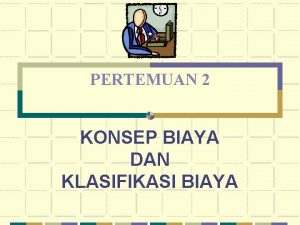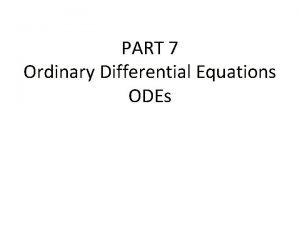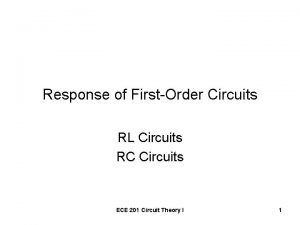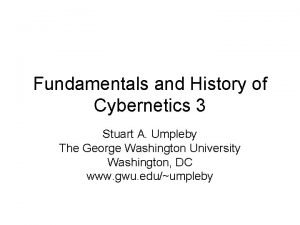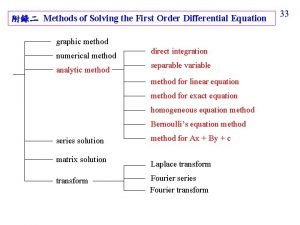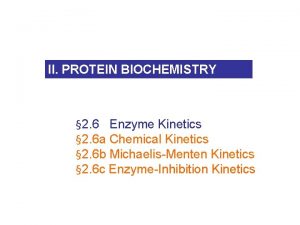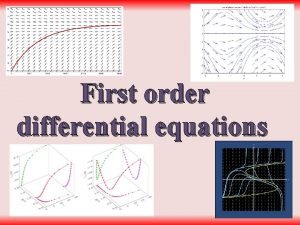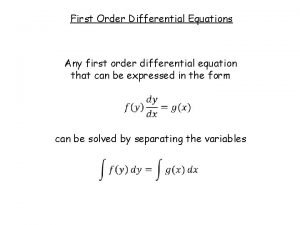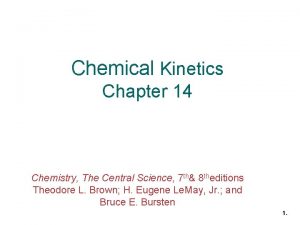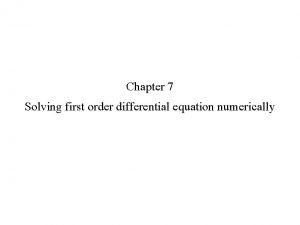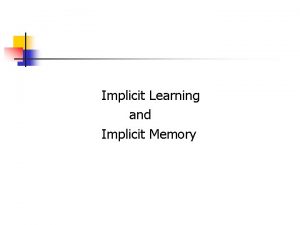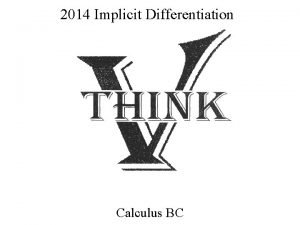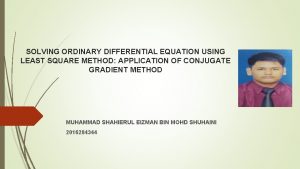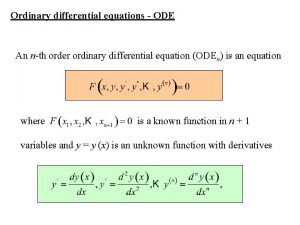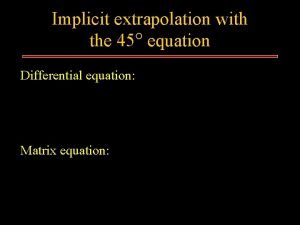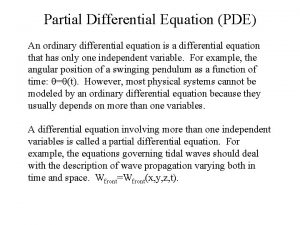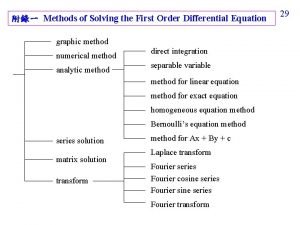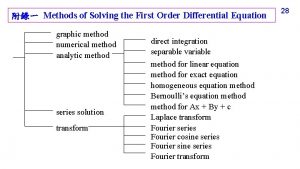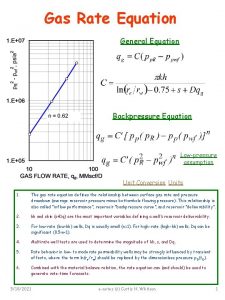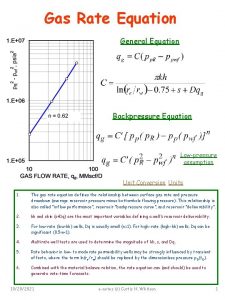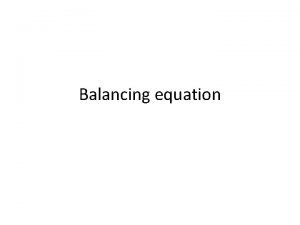SOLVING FIRST ORDER ORDINARY DIFFRENTIAL EQUATION USING IMPLICIT















- Slides: 15

SOLVING FIRST ORDER ORDINARY DIFFRENTIAL EQUATION USING IMPLICIT MULTISEP ADAMS-MOULTON METHOD SITI NUR AISYAH BT ISA 2017696382 Supervisor: Dr. Rivaie Bin Mohd Ali

Background of study According by Polla, 2013, there are many numerical methods to solve ordinary differential equations (ODE) related to the initial value problem (IVP) that is the single-step method and multiple-step method. The multistep method is a method that needs multiple points from more than one of the previous points to start and run the formula. Examples of the multistep method include the Adams. Bashford method, the Adams-Moulton method, and the Milne method. This method uses the approach at more than one point before to determine the approach to the next point called the multistep method. The precise definition of this method is followed, along with the definition of two types of multistep methods namely Adam-Bashforth and Adam-Moulton (Richard L. Burden & J. Douglas, 2005). This study will compare the efficiency between different versions of the Adams-Moulton method by comparing the 2 -Step, 3 -Step, and 4 -Step Adams. Moulton accuracy.

PROBLEM STATEMENT There are several methods to solve the ODE problems either by using a theoretical or numerical method. A theoretical method is rarely being used by mathematicians to solve ODE problems since it is complicated and has a longer calculation compared to the numerical method. Moreover, the numerical method also has its constraints where it requires the first few initial points that can be obtained using a single-step method. The single-step method that is mostly used is the Runge-Kutta method of order four. It is a good choice for common purposes because it is quite accurate, stable, and easy to program. Therefore, the main problem is to find the correct formula to be used and blend together which is the Runge-Kutta and Adams-Moulton method. It is still unknown which version of the Adams. Moulton multistep method is the best to approximate the solution of ODE numerically. Hence, this study tries to compare the accuracy and performance of a different version of the Adams-Moulton method.

OBJECTIVE To solve the first order ODE theoretically using theoretical method. To solve first order ODE numerically using Adams-Moulton method. To analysis efficiency of Adams-Moulton version to solve first order ODE. To determine the best Adams-Moulton multistep method for solving first order ODE.

SIGNIFICANCE OF THE PROJECT This project is focused on finding which Adams- Moulton method is the best for solving the ODE problem based on the Central Processing Unit (CPU) time and error analysis. However, to use this method should solve Adams-Bashforth firstly followed by Adams-Moulton. This study compared the efficiency between different versions of Adams-Moulton method by computing the error and central processing unit (CPU) time to determine the most efficient method. The ODE problem is one of the main topics that has been frequently used in realworld nowadays applications such as in engineering physics, economics, and chemistry. This project hopefully can be benefit other researchers to employ the best the Adams-Moulton method in terms of efficiency and can be used for further research.

LITERATURE REVIEW According to Marciniak (2007), applying numerical methods on computers we deal with data representation error sand errors caused by floating-point arithmetic. For all kinds of Runge-Kutta methods considered have proved theorems that the exact solution of the initial value problem belongs to the intervals obtained. The main advantage of the selected Runge-Kutta method is that it is easy to implement and extremely stable. This method is known as the 'self-start' method where by new solution points are calculated based on the previous point (Fitzpatrick, 2006). Therefore, this study will compare Adams-Moulton's accuracy based on 2 -Step, 3 -Step, and 4 -Step. The error of each method will be analysed based on theoretical solution. The Central processing unit (CPU) time will be compared to get the most efficient method.

METHODOLOGY

Expected Result Performance Profile Based on Central Processing Unit (CPU) Time Profile Performance Based on Error

Performance Profile Based on Error Performance Profile of Error Analysis for Different Version of Adams. Moulton Method

Performance Profile of Error Analysis for Different Step-Size

Performance Profile Based on Central Processing Unit (CPU) Time Performance Profile of CPU Time for Difference Version Adams. Moulton method

Performance Profile of CPU Time for Difference Step-Size

Gantt Chart

Refference Jankowska, M. , & Marciniak, A. (2006). On two families of implicit interval methods of Adams. Moulton type. Computational Methods in Science and Technology, 12(2), 109 -113. Gajda, K. , Jankowska, M. , Marciniak, A. , & Szyszka, B. (2007, September). A survey of interval Runge–Kutta and multistep methods for solving the initial value problem. In International Conference on Parallel Processing and Applied Mathematics (pp. 1361 -1371). Springer, Berlin, Heidelberg. Marciniak, A. (2004). Implicit interval methods for solving the initial value problem. Numerical Algorithms, 37(1 -4), 241 -251. Thompson, A. M. , Steel, C. M. , Chetty, U. , & Carter, D. C. (1992). Evidence for the multistep theory of carcinogenesis in human breast cancer. The Breast, 1(1), 29 -34. Dahlquist, G. G. (1963). A special stability problem for linear multistep methods. BIT Numerical Mathematics, 3(1), 27 -43. Guo, L. , Zeng, F. , Turner, I. , Burrage, K. , & Karniadakis, G. E. (2019). Efficient multistep methods for tempered fractional calculus: Algorithms and simulations. SIAM Journal on Scientific Computing, 41(4), A 2510 -A 2535. Albi, G. , Dimarco, G. , & Pareschi, L. (2019). Implicit-Explicit multistep methods for hyperbolic systems with multiscale relaxation. ar. Xiv preprint ar. Xiv: 1904. 03865.

Thank You
 Diffrential media
Diffrential media Pengertian klasifikasi biaya
Pengertian klasifikasi biaya First order ordinary differential equations
First order ordinary differential equations Example of ordinary differential equation
Example of ordinary differential equation Differential formula
Differential formula Solving first order circuits
Solving first order circuits Via optica
Via optica First and second order change
First and second order change First order cybernetics and second order cybernetics
First order cybernetics and second order cybernetics Variable separable
Variable separable Lineweaver-burk equation
Lineweaver-burk equation Find the general solution of the differential equation
Find the general solution of the differential equation Solving 1st order differential equations
Solving 1st order differential equations Integrating factor of linear differential equation
Integrating factor of linear differential equation Half life of first order reaction
Half life of first order reaction Highest order chapter 7
Highest order chapter 7

